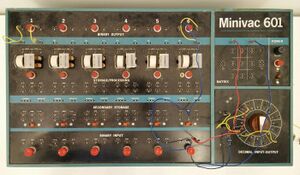Engineering:Minivac 601
 | |
| Developer | Claude Shannon |
|---|---|
| Manufacturer | Scientific Development Corporation (Cambridge, Massachusetts, later in Watertown, Massachusetts) |
| Type | Electromechanical |
| Release date | c.1961 |
| Introductory price | US$85 (equivalent to $727.23 in 2019) |
| CPU | (None) |
| Memory | 6 bits |
| Storage | 6 bits |
| Display | 6 indicator lamps, 16-position motorized dial |
| Input | 6 slide switches, 6 pushbutton switches, 16-position motorized dial |
| Power | 110 VAC |
| Dimensions | 5 1/8 x 24 x 13 1/4 in.[1] |
| Mass | 9 kilograms (20 lb) |
Minivac 601 Digital Computer Kit was an electromechanical digital computer system created by information theory pioneer Claude Shannon as an educational toy using digital circuits.[2]
Description
In 1961, the system was sold by Scientific Development Corporation's "Consumer Products Division",[2] which was soon renamed as the "Digital Equipment Division".[3] The Minivac 601 was originally housed in a blue-painted wooden case. It used DPDT electrical relays as logic switches and for temporary data storage. The main board had a six-bit binary input/output array, consisting of simple DPDT slide switches, SPDT pushbutton switches, and indicator lights. A 16-position motorized dial rotary switch could be used to input decimal or hexadecimal numbers, to output numbers, or to act as a clock signal generator.
The components could be interconnected by manually inserting jumper wires fitted with tapered pin connectors into sockets on the main circuit board. The combined components just barely allowed the simple computer to play a winning game of Tic-Tac-Toe, or to simulate a simple elevator control system.
An "advanced and improved" version called the Minivac 6010 was released in early 1962, housed in a gray metal case and featuring higher-quality components.[4] It was supplied with additional patch cords incorporating special resistors, capacitors, and diodes for further capabilities.[which?][4] Although the price was also increased considerably, the system was more successfully sold to the corporate market, rather than as a toy.[5]
In 1962, the Scientific Development Corporation also advertised educational electronic kits based on analog electronics technology.[6]
Gallery
References
- ↑ MINIVAC 601 Computer History Museum, "Description: This item comprises two pieces: A: Main unit B: Bag of jumper cables Produced by SDC Corporation, Watertown, MA. Operates from 110VAC. Object consists of: minivac, original cardboard box, 3 bags of jumper cables, 6 electrolitic [sic] capacitors..."
- ↑ 2.0 2.1 Advertisement: Minivac 601, Page 33, 1961-10, Popular Science
- ↑ Advertisement: Minivac 601, Page 31, 1961-11, Popular Science
- ↑ 4.0 4.1 "Minivac 6010". http://www.oldcomputermuseum.com/minivac_6010.html. Retrieved 2016-05-01.
- ↑ Price and Perceived Value Chapter 3, Page 11, Marketing That Works: How Entrepreneurial Marketing Can Add Sustainable Value to Any Sized Company, By Leonard M. Lodish; Howard L. Morgan; Shellye Archambeau, ISBN:978-0-13-239075-0, "...the entrepreneur's line was the ...MINIVAC 601...no one in the third segment, the corporate sector, bought the product...the corporate types was: "Oh, that—it's just a toy!" The entrepreneur was creative and he listened carefully. He also understood marketing. His next product was the same basic kit—with the switches upgraded to higher tolerances and the machine color changed from blue and red to gunmetal gray. The name was changed to the MINIVAC 6010 and he increased the price from $79.95 to $479. The MINIVAC 6010 sold very well to the corporate segment at $479..."
- ↑ Advertisement: Basic Communications Kits, Page 16, 1962-06, Popular Science
External links
- Cedmagic.com
- Hal A. Layer
- Computermuseum.li
- Minivac 601 at www.oldcomputermuseum.com
- Minivac 6010 at www.oldcomputermuseum.com
- Minivac 601 documentation (1961): Book I, Books II-IV, Books V-VI, Maintenance manual


